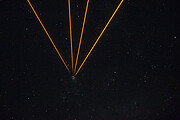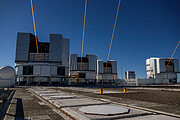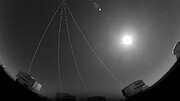Press Release
Laser trial run kickstarts new era of interferometry
10 November 2025
Last week, four lasers were projected into the skies above the European Southern Observatory’s (ESO’s) Paranal site in Chile. The lasers are each used to create an artificial star, which astronomers use to measure and then correct the blur caused by Earth's atmosphere. The striking launch of these lasers, one from each of the eight-metre telescopes at Paranal, is a significant milestone of the GRAVITY+ project — a large and complex upgrade to ESO’s Very Large Telescope Interferometer (VLTI). GRAVITY+ unlocks a greater observing power and a much wider sky coverage for the VLTI than previously possible.
“This is a very important milestone for a facility that is completely unique in the world,” says Antoine Mérand, an ESO astronomer and VLTI Programme Scientist.
The VLTI combines light from several individual telescopes of the VLT (either the four eight-metre Unit Telescopes (UTs) or the four smaller Auxiliary Telescopes) using interferometry. GRAVITY+ is an upgrade to the VLTI, with a focus on GRAVITY, a very successful VLTI instrument that has been used to image exoplanets, observe stars near and far and perform detailed observations of faint objects orbiting the Milky Way’s supermassive black hole. GRAVITY+ also encompasses infrastructural changes to the telescopes and upgrades to the VLTI underground tunnels, where the light beams are brought together. The installation of a laser at each of the previously unequipped UTs is a key achievement of this long-term project, transforming the VLTI into the most powerful optical interferometer in the world.
“The VLTI with GRAVITY has already enabled so many unpredicted discoveries, we are excited to see how GRAVITY+ will push the boundaries even further,” says GRAVITY+ Principal Investigator Frank Eisenhauer of the Max-Planck Institute for Extraterrestrial Physics (MPE), Germany, which led the consortium carrying out the upgrade. [1]
The series of upgrades has been ongoing for a few years and includes revised adaptive-optics technology — a system to correct the blur caused by the Earth’s atmosphere — with advanced state-of-the-art sensors and deformable mirrors. Until now, for the VLTI, adaptive-optics corrections have been done by pointing to bright reference stars that need to be close to the target, limiting the number of objects we can observe. With the installation of a laser at each of the UTs, a bright artificial star is created 90 km above Earth’s surface, enabling the correction of atmospheric blur anywhere on the sky. This unlocks the whole southern sky to the VLTI and enhances its observing power dramatically.
“This opens up the instrument to observations of objects in the early distant Universe, such as the quasar we observed on the second night where we resolved the hot, oxygen emitting gas very close to the black hole,” says Taro Shimizu, an MPE astronomer who is a member of the instrument consortium. With lasers on the telescopes used by the VLTI, astronomers will be able to study distant active galaxies and directly measure the mass of the supermassive black holes that power them, as well as observe young stars and the planet-forming discs around them.
The VLTI’s improved capabilities will drastically increase the amount of light that can travel through the system, making the facility up to 10 times more sensitive. “A big goal of GRAVITY+ is to allow for deep observations of faint targets,” explains Julien Woillez, an ESO astronomer and GRAVITY+ project scientist. This increased ability to detect dimmer objects will allow observations of isolated stellar black holes, free-floating planets that do not orbit a parent star and stars closest to the Milky Way’s supermassive black hole Sgr A*.
A first target for the GRAVITY+ and ESO teams at Paranal performing test observations using the new lasers was a cluster of massive stars at the centre of the Tarantula Nebula, a star-forming region in our neighbouring galaxy the Large Magellanic Cloud. These first observations revealed that a bright object in the nebula, thought to be an extremely massive single star, is actually a binary of two stars close together. This showcases the stunning capabilities and scientific potential of the upgraded VLTI.
This improvement is beyond just an update and was first envisioned decades ago. The laser system was suggested in the final report of the “Very Large Telescope Project” in 1986 before the VLTI even existed: “If it could work in practice, it would be a breakthrough,” the report stated. Now this breakthrough is a reality.
Notes
[1] The GRAVITY+ consortium consists of the following partners:
- Max Planck Institute for Extraterrestrial Physics (MPE); Max Planck Institute for Astronomy; University of Cologne (Germany)
- Institut National des Sciences de l'Univers, French National Centre for Scientific Research; Institut de Planétologie et d'Astrophysique de Grenoble; Laboratoire d’instrumentation et de recherche en astrophysique (LIRA); Lagrange Laboratory; Centre de Recherche Astrophysique de Lyon (France)
- Instituto Superior Técnico’s Centre for Astrophysics and Gravitation (CENTRA); University of Lisbon; University of Porto (Portugal)
- University of Southampton (UK)
- Katholieke Universiteit Leuven (Belgium)
- University College Dublin (Ireland)
- Instituto de Astronomia – Universidad Nacional Autónoma de México (Mexico)
- European Southern Observatory.
More information
The GRAVITY+ Co-Investigators are: Frank Eisenhauer (PI; MPE, Germany), Paulo Garcia (Faculdade de Engenharia, Universidade do Porto and CENTRA research unit, Portugal), Sebastian Hönig (University of Southampton, UK), Laura Kreidberg (Max Planck Institute for Astronomy, Germany), Jean-Baptiste Le Bouquin (Institut de Planétologie et d'Astrophysique de Grenoble, Université Grenoble Alpes, France), Thibaut Paumard (LIRA, Observatoire de Paris, France), Christian Straubmeier (University of Cologne, Germany).
At ESO, the GRAVITY+ upgrade is led by Frederic Gonte (Project Manager), Julien Woillez (Project Scientist), Sylvain Oberti (Project Engineer), and Luis Esteras Otal (VLTI Systems Engineer).
ESO’s Paranal Observatory in Chile is currently under threat by the planned INNA project, set to be located just 11 kilometres from the VLTI. An especially worrying impact from INNA is due to microvibrations since they make combining light in the VLTI tunnels much more challenging. In fact, a detailed technical analysis performed earlier this year revealed that INNA’s wind turbines could produce an increase in ground vibrations large enough to impair VLTI operations. Relocating planned projects such as INNA from the areas surrounding Paranal is key to allowing world-class astronomical facilities to operate at their maximum potential, as well as to protecting a truly special place with pristine dark skies and other conditions that make it an astronomy world-leader.
The European Southern Observatory (ESO) enables scientists worldwide to discover the secrets of the Universe for the benefit of all. We design, build and operate world-class observatories on the ground — which astronomers use to tackle exciting questions and spread the fascination of astronomy — and promote international collaboration for astronomy. Established as an intergovernmental organisation in 1962, today ESO is supported by 16 Member States (Austria, Belgium, Czechia, Denmark, France, Finland, Germany, Ireland, Italy, the Netherlands, Poland, Portugal, Spain, Sweden, Switzerland and the United Kingdom), along with the host state of Chile and with Australia as a Strategic Partner. ESO’s headquarters and its visitor centre and planetarium, the ESO Supernova, are located close to Munich in Germany, while the Chilean Atacama Desert, a marvellous place with unique conditions to observe the sky, hosts our telescopes. ESO operates three observing sites: La Silla, Paranal and Chajnantor. At Paranal, ESO operates the Very Large Telescope and its Very Large Telescope Interferometer, as well as survey telescopes such as VISTA. Also at Paranal, ESO will host and operate the south array of the Cherenkov Telescope Array Observatory, the world’s largest and most sensitive gamma-ray observatory. Together with international partners, ESO operates ALMA on Chajnantor, a facility that observes the skies in the millimetre and submillimetre range. At Cerro Armazones, near Paranal, we are building “the world’s biggest eye on the sky” — ESO’s Extremely Large Telescope. From our offices in Santiago, Chile we support our operations in the country and engage with Chilean partners and society.
Links
- Photos of the VLT/I
- ESO's blog post on GRAVITY+
- ESO's GRAVITY+ page
- MPE's GRAVITY+ page
- For journalists: subscribe to receive our releases under embargo in your language
- For scientists: got a story? Pitch your research
- New ESO analysis confirms severe damage from industrial complex planned near Paranal
Contacts
Frank Eisenhauer
Max Planck Institute for Extraterrestrial Physics
Garching bei München, Germany
Tel: +49 89 30000 3100
Email: eisenhau@mpe.mpg.de
Taro Shimizu
Max Planck Institute for Extraterrestrial Physics
Garching bei München, Germany
Tel: +49 89 30000 3392
Email: shimizu@mpe.mpg.de
Jean-Baptiste Le Bouquin
Institut National des Sciences de l’Univers, CNRS
Grenoble, France
Tel: +33 4 76 14 36 82
Email: jean-baptiste.lebouquin@univ-grenoble-alpes.fr
Antoine Mérand
European Southern Observatory
Garching bei München, Germany
Tel: +49 89 3200 6630
Email: amerand@eso.org
Julien Woillez
European Southern Observatory
Garching bei München, Germany
Tel: +49 89 3200 6273
Email: jwoillez@eso.org
Bárbara Ferreira
ESO Media Manager
Garching bei München, Germany
Tel: +49 89 3200 6670
Cell: +49 151 241 664 00
Email: press@eso.org
About the Release
| Release No.: | eso2519 |
| Name: | GRAVITY |
| Type: | Unspecified : Technology : Observatory |
| Facility: | Very Large Telescope Interferometer |
| Instruments: | GRAVITY |
Our use of Cookies
We use cookies that are essential for accessing our websites and using our services. We also use cookies to analyse, measure and improve our websites’ performance, to enable content sharing via social media and to display media content hosted on third-party platforms.
ESO Cookies Policy
The European Organisation for Astronomical Research in the Southern Hemisphere (ESO) is the pre-eminent intergovernmental science and technology organisation in astronomy. It carries out an ambitious programme focused on the design, construction and operation of powerful ground-based observing facilities for astronomy.
This Cookies Policy is intended to provide clarity by outlining the cookies used on the ESO public websites, their functions, the options you have for controlling them, and the ways you can contact us for additional details.
What are cookies?
Cookies are small pieces of data stored on your device by websites you visit. They serve various purposes, such as remembering login credentials and preferences and enhance your browsing experience.
Categories of cookies we use
Essential cookies (always active): These cookies are strictly necessary for the proper functioning of our website. Without these cookies, the website cannot operate correctly, and certain services, such as logging in or accessing secure areas, may not be available; because they are essential for the website’s operation, they cannot be disabled.
Functional Cookies: These cookies enhance your browsing experience by enabling additional features and personalization, such as remembering your preferences and settings. While not strictly necessary for the website to function, they improve usability and convenience; these cookies are only placed if you provide your consent.
Analytics cookies: These cookies collect information about how visitors interact with our website, such as which pages are visited most often and how users navigate the site. This data helps us improve website performance, optimize content, and enhance the user experience; these cookies are only placed if you provide your consent. We use the following analytics cookies.
Matomo Cookies:
This website uses Matomo (formerly Piwik), an open source software which enables the statistical analysis of website visits. Matomo uses cookies (text files) which are saved on your computer and which allow us to analyze how you use our website. The website user information generated by the cookies will only be saved on the servers of our IT Department. We use this information to analyze www.eso.org visits and to prepare reports on website activities. These data will not be disclosed to third parties.
On behalf of ESO, Matomo will use this information for the purpose of evaluating your use of the website, compiling reports on website activity and providing other services relating to website activity and internet usage.
Matomo cookies settings:
Additional Third-party cookies on ESO websites: some of our pages display content from external providers, e.g. YouTube.
Such third-party services are outside of ESO control and may, at any time, change their terms of service, use of cookies, etc.
YouTube: Some videos on the ESO website are embedded from ESO’s official YouTube channel. We have enabled YouTube’s privacy-enhanced mode, meaning that no cookies are set unless the user actively clicks on the video to play it. Additionally, in this mode, YouTube does not store any personally identifiable cookie data for embedded video playbacks. For more details, please refer to YouTube’s embedding videos information page.
Cookies can also be classified based on the following elements.
Regarding the domain, there are:
- First-party cookies, set by the website you are currently visiting. They are stored by the same domain that you are browsing and are used to enhance your experience on that site;
- Third-party cookies, set by a domain other than the one you are currently visiting.
As for their duration, cookies can be:
- Browser-session cookies, which are deleted when the user closes the browser;
- Stored cookies, which stay on the user's device for a predetermined period of time.
How to manage cookies
Cookie settings: You can modify your cookie choices for the ESO webpages at any time by clicking on the link Cookie settings at the bottom of any page.
In your browser: If you wish to delete cookies or instruct your browser to delete or block cookies by default, please visit the help pages of your browser:
Please be aware that if you delete or decline cookies, certain functionalities of our website may be not be available and your browsing experience may be affected.
You can set most browsers to prevent any cookies being placed on your device, but you may then have to manually adjust some preferences every time you visit a site/page. And some services and functionalities may not work properly at all (e.g. profile logging-in, shop check out).
Updates to the ESO Cookies Policy
The ESO Cookies Policy may be subject to future updates, which will be made available on this page.
Additional information
For any queries related to cookies, please contact: pdprATesoDOTorg.
As ESO public webpages are managed by our Department of Communication, your questions will be dealt with the support of the said Department.









